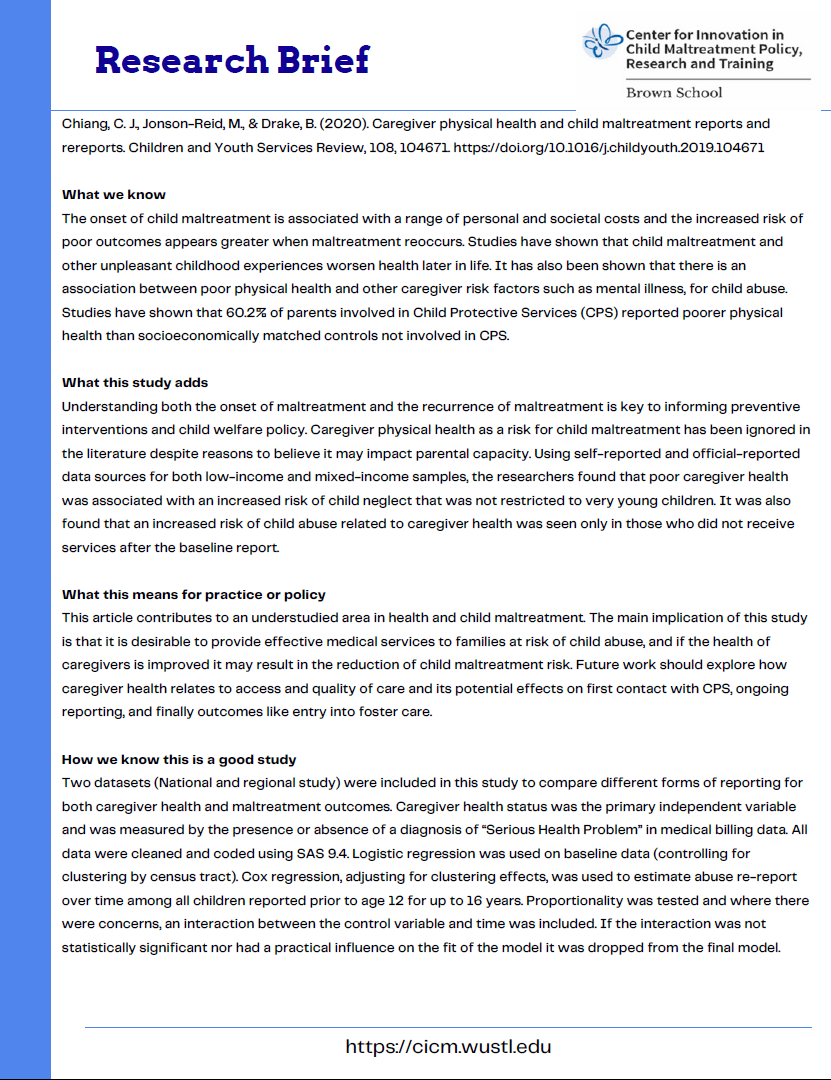Caregiver Physical Health and Child Maltreatment Reports and Rereports
Research Brief

Chiang, C. J., Jonson-Reid, M., & Drake, B. (2020). Caregiver physical health and child maltreatment reports and rereports. Children and Youth Services Review, 108, 104671.
What we know
The onset of child maltreatment is associated with a range of personal and societal costs and the increased risk of poor outcomes appears greater when maltreatment reoccurs. Studies have shown that child maltreatment and other unpleasant childhood experiences worsen health later in life. It has also been shown that there is an association between poor physical health and other caregiver risk factors such as mental illness, for child abuse. Studies have shown that 60.2% of parents involved in Child Protective Services (CPS) reported poorer physical health than socioeconomically matched controls not involved in CPS.
What this study adds
Understanding both the onset of maltreatment and the recurrence of maltreatment is key to informing preventive interventions and child welfare policy. Caregiver physical health as a risk for child maltreatment has been ignored in the literature despite reasons to believe it may impact parental capacity. Using self-reported and official-reported data sources for both low-income and mixed-income samples, the researchers found that poor caregiver health was associated with an increased risk of child neglect that was not restricted to very young children. It was also found that an increased risk of child abuse related to caregiver health was seen only in those who did not receive services after the baseline report.
What does this mean for practice or policy
This article contributes to an understudied area in health and child maltreatment. The main implication of this study is that it is desirable to provide effective medical services to families at risk of child abuse, and if the health of caregivers is improved it may result in the reduction of child maltreatment risk. Future work should explore how caregiver health relates to access and quality of care and its potential effects on first contact with CPS, ongoing reporting, and finally outcomes like entry into foster care.
How do we know this is a good study
Two datasets (National and regional study) were included in this study to compare different forms of reporting for both caregiver health and maltreatment outcomes. Caregiver health status was the primary independent variable and was measured by the presence or absence of a diagnosis of “Serious Health Problem” in medical billing data. All data were cleaned and coded using SAS 9.4. Logistic regression was used on baseline data (controlling for clustering by census tract). Cox regression, adjusting for clustering effects, was used to estimate abuse re-report over time among all children reported prior to age 12 for up to 16 years. Proportionality was tested and where there were concerns, an interaction between the control variable and time was included. If the interaction was not statistically significant nor had a practical influence on the fit of the model it was dropped from the final model.